SPIE: “A billion windows on quantum dots”
Tiny engineered nanocrystals may give windows renewed purpose
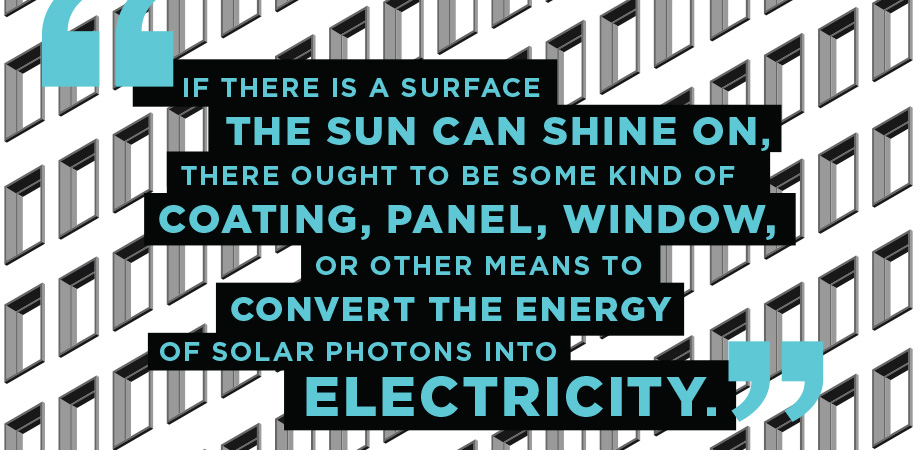
Halfway around the world in 2019, a development firm built an "entrance porch" at the Warwick Grove Shopping Centre in Perth, Australia, to test an assembly of 18 solar windows supplied by the local firm ClearVue PV. Largely transparent even as they generate modest amounts of electricity, the windows have undergone testing to identify what improvements remain to be achieved before these so-called building-integrated photovoltaics can be deployed in the constructed landscape.
Walk along the sunny southeast façade of Boulder Commons, a pioneering net-zero energy (NZE) development project that opened in 2017 in Colorado, and you will see four-story walls clad with 655 photovoltaic (PV) panels. Taking the place of what would have been the metal panels, brick, and glass on the other external walls of the roughly 100,000 square-foot complex, these dark silicon PV panels generate 205 of the complex's 575 kW power-generating needs. This was a crucial, albeit unpretty, design innovation because the 370 kW delivered by the additional 1,072 roof-installed PV panels would have been insufficient for the complex to achieve NZE.
What materials scientist Lance Wheeler of the US Department of Energy's National Renewable Energy Laboratory (NREL) in Golden, Colorado, sees in demonstrations like these are baby steps toward realizing the "energy everywhere" mantra he embraces. Wheeler believes that if there is a surface the sun can shine on, there ought to be some kind of coating, panel, window, or other means to convert the energy of solar photons into electricity.
This is an aspiration with many potential solutions, and Wheeler is among a cadre of green-energy researchers who are bullish on the role that some of the tiniest engineered crystals on the planet will play. Known often as quantum dots (QD), these are nanoscale crystals of semiconductor compositions whose knack for photonics play first became apparent in a materials science laboratory in Russia in 1980. Research since then has revealed that these nanocrystals, which are comparable in size to viruses and contain hundreds to thousands of atoms, can pull off fantastic photonics and electronic abracadabras. Beginning around the turn of the millennium, entrepreneurially minded quantum-dot players began to see their science undergird commercial technology in applications that now range from televisions and tablets, to cellular labeling agents and medical therapeutics.
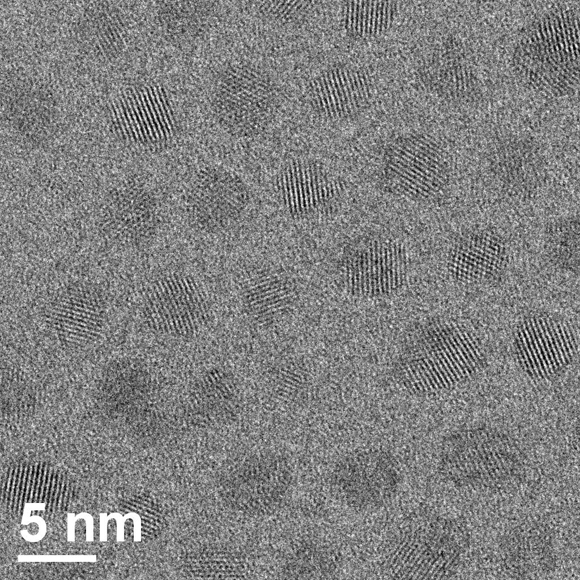
TEM image of quantum dots on an ultrathin carbon support. Lattice fringes of the crystals are visible. Credit: UbiQD, Inc.
For their part at NREL, Wheeler and colleagues have been investigating the synthesis of photoactive nano-materials, including quantum dots, and how to use these in green-energy applications, such as solar windows. Solar windows must pull off a seemingly incompatible double feat: they have to be see-through, because that's the raison d'etre for windows, while also intercepting sunlight to generate electricity. Now think of billions and billions of square feet of solar windows on skyscrapers and buildings all over the constructed landscape and you begin to see how nanometer-scale quantum dots could participate in solving global-scale environmental threats.
"PV windows could become a great solution" for achieving NZE buildings like those in the Boulder Commons complex, says Wheeler. After all, he noted, "buildings account for 70 percent of electricity use." There are challenges ahead. If you're in the solar window game and you have any realistic hope that architects, developers, the construction industry, and building occupants will embrace novel window technology, then your products will have to hit a sweet spot that combines power efficiency, transparency, affordability, good aesthetics, durability, reliability, and industry certifications, among others. No one has done that quite yet.
The QD Awakening
Anybody who, like Wheeler, intends to deploy some of the material world's smallest structures to heal one of the planet's largest and most troubled structures—an overheating atmosphere due to rising carbon dioxide levels—can draw a line from their current work to about 1980. That's when Alexey Ekimov, a materials scientist at the Vavilov State Optical Institute in St. Petersburg, was investigating the origin of color in filter glass whose formulations included semiconductor ingredients, such as cadmium sulfide and copper chloride.
Ekimov traced the color to nanoscale crystal inclusions of those semiconductors. He also noticed that these nanocrystals had the curious property of absorbing light of shorter wavelengths than expected from the behavior of these same materials in bulk formats. Ekimov teamed with theoretician Alexander Efros, at the nearby Ioffe Institute. The two scientists showed that the absorption and emission spectra of nanocrystals were determined by their sizes, not their compositions. It was as though one lightbulb filament could be made to emit any color just by making the filament bigger or smaller. "It is an amazing and wonderful property," says Efros, who since 1993 has been studying nanomaterials at the US Naval Research Laboratory in Washington, DC.
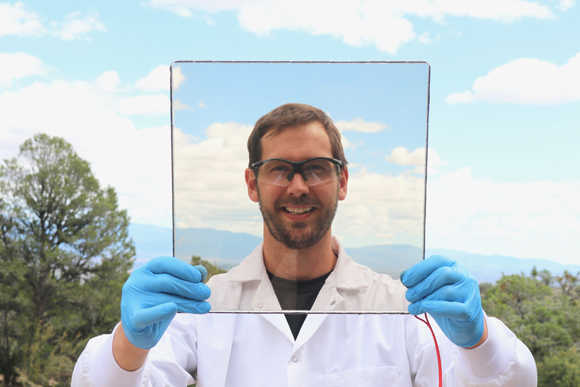
This prototype of a QD-infused solar window can harvest sunlight for conversion into electricity. Photons make their way to solar cells at the edges to generate electricity for powering the structure hosting the window. It remains mostly transparent, with a slight tint. The windows have since moved beyond prototypes and have been installed in buildings. Credit: UbiQD, Inc.
In the same timeframe, Louis Brus, then working on colloidal syntheses of cadmium sulfide nanocrystals at Bell Labs, managed to produce a series of nanocrystals with sizes down to just a few nanometers. Working with him were young scientists, including Paul Alivasatos (named in February as the next president of the University of Chicago) and Moungi Bawendi, Massachusetts Institute of Technology (MIT), who would become giants in the field of semiconductor nano-crystals. Alivasatos would also help initiate an early wave of quantum-dot commercialization by cofounding in 1999, the Quantum Dot Corporation (now part of Fischer Scientific) for cancer diagnostics and medical research, and Nanosys in 2001, which opened the way for quantum-dot-enhanced TV and electronic displays.
What the quantum-dot pioneers were learning was that the very same chemical substance, if embodied as nanocrystals, could emit any wavelength in and around the visible range just by controlling the size of the nanocrystal. The smaller particles, when energized with ambient light, emit toward the blue side of the spectrum. The large nanocrystals emit toward the redder side. Nanocrystals with intermediate diameters fill in the rainbow. This set nanocrystals apart from chunks, wafers, and other bulk forms of semiconductors, whose bandgaps are of set energies and whose absorption and emission spectra are therefore also unchanging.
Because the behavior of electronic and photonic energies in the different-sized nanocrystals resembles the quantized behavior in atoms, semiconductor nanocrystals garnered the nickname from some as "artificial atoms," and more commonly as "quantum dots."
A Would-Be Window Maker
Materials scientist and quantum-dot entrepreneur Hunter McDaniel pegs some of his embrace of quantum dots to his purchase in 2014 of one the first commercial QD products: an Amazon Kindle Fire tablet whose brilliant color display was made possible with quantum-dot technology from Nanosys. It was a hold-in-your-hand demonstration that quantum dots had become commercial technology and helped inspire McDaniel to take his own entrepreneurial leap by launching UbiQD, based in Los Alamos, New Mexico, where at the time he had been a postdoctoral research associate at Los Alamos National Laboratory (LANL). The company's name is the short version of the phrase "ubiquitous quantum dots" and pronounced as "ubiquity." The technological foundations and intellectual property for UbiQD's R&D and first products emerged from research at LANL, MIT, the University of Washington, and Western Washington University.
The design of the company's experimental solar windows, and pretty much any other solar window now under development, goes something like this:
- Infuse one or more layers of a window glass assembly with quantum dots, organic dyes, or another photoactive material that absorbs some of the sunlight and converts it into a glow of infrared photons.
- Trap the near-IR glow in the plane of the window by internal reflection.
- Guide the photonic glow to photovoltaic cells in the edges of the window.
- Use that energy to run the building's systems and, if you have made enough power, to feed into the grid and even power up tenants' electric vehicles.
In its experimental solar windows, UbiQD's quantum-dot systems consist of copper-indium sulfide cores clad in zinc sulfide shells. These core/shell quantum dots provide a nontoxic alternative to the lead- and cadmium- containing QDs that started the QD era but that McDaniel felt would prove problematic for large-scale commercial QD applications. A pivotal physics nuance of the CuInS2/ZnS quantum-dot materials resides in their favorable so-called Stokes shift. This means that the absorption spectra and emission spectra of these QDs do not overlap, thereby preventing one quantum dot in the window from absorbing the emission of another—a fatal flaw in other solar window designs.
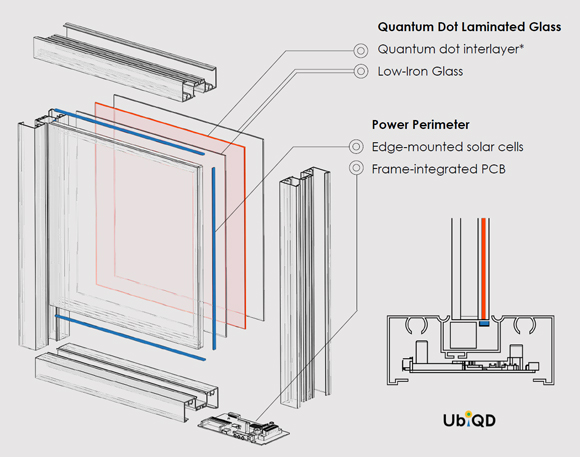
This schematic illustrates the design of UbiQD's PV windows. Credit: UbiQD
Last summer, McDaniel and UbiQD colleagues reported that they had taken a step toward commercial solar windows that could, in theory, provide up to 40 percent of a building's energy needs. Combine that, McDaniel says, with a building full of next-generation, energy-efficient, smartly controlled systems, and you have a pathway to an era of NZE buildings.
The UbiQD team has been experimenting with assemblies of low-iron commercial glass, which allows more infrared light to transmit through it than higher-iron glass, with luminescent solar concentrator (LSC) glass layers infused with their CuInS2/ZnS quantum dots. The team reports that their best assemblies so far deliver an NREL-certified 3.6 percent power conversion efficiency (of sunlight to electricity), which the UbiQD team rates as "a new champion efficiency for this technology." That's much less than commercial silicon PV panels, which deliver efficiencies in the range 15–20 percent, but enough to begin making sense for solar windows that can generate much of a building's energy needs even as they let most of the sunlight pass through. To offset the maple-syrup tinge their QDs impart to the windows, the team added a blue pigment, thereby producing a more marketable color-neutral window. But that fix added an unwelcome "haze" that reduced the amount of light reaching the windows' PV cells attached at the edges.
McDaniel acknowledges there is a lot of optimization work ahead, but the incentives are compelling enough to push on. "There is an $80-billion annual market for windows in new construction," McDaniel says. "Retrofitting existing buildings could amount to another $10 billion in potential market for each major urban center." The global green-energy win would be earned by converting as many of these buildings as possible from being loads on the grid to being assets. "The only way to do that is with glass," says McDaniel, noting there simply is not enough roof real-estate available on buildings for rooftop solar cells to do the job themselves.
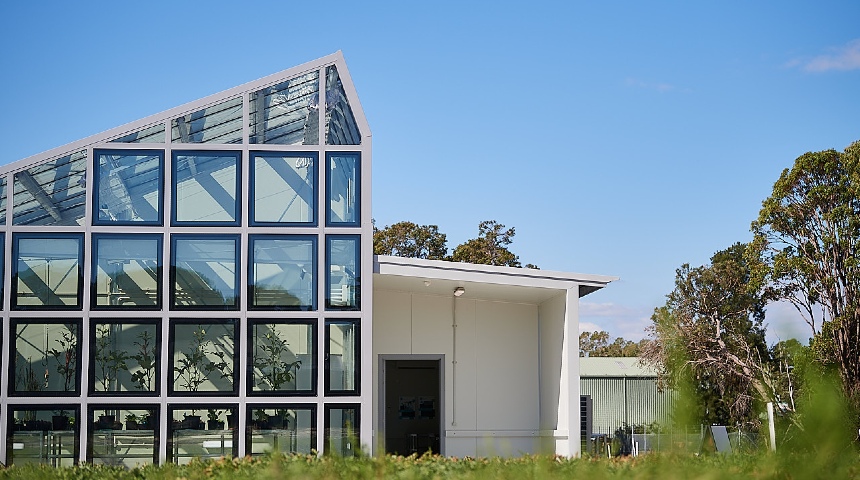
ClearVue's solar greenhouse at Murdoch University in Australia. Credit: Murdoch University
To remain alive as it moves toward realizing a solar window vision, UbiQD has been selling its first commercial product (by way of the spinoff company UbiGro) for the vast greenhouse agriculture market. They infused QDs into plastic film that reconditions sunlight passing through it—the UVs and blues get converted into growth-promoting oranges and reds. The film ends up amplifying greenhouse crop yields and increasing profits for the greenhouse owners. The company's wide-eyed projections puts the total accessible market in the greenhouse sector for their QD films at about $4 billion per year.
McDaniel welcomes the growth in sales for the company's greenhouse films. But, he says, "we always have thought windows would become our best market for the material." That's where those baby steps come in. This year, UbiQD will be installing test windows in several buildings, including their own headquarters, a Holiday Inn Express, and another undisclosed venue.
ClearVue also has demonstration projects in the works. With some of the greenhouse market in its sights, for one, the company joined Murdoch University, with an announcement in April of the opening of what these partners claim is "the world's first clear solar glass greenhouse."
UbiQD and ClearVue are among the more visible players in the competition to bring solar windows to market, but there are others in the game. One of these, Ubiquitous Energy, based in Redwood City, California, told Forbes contributor Scott Snowden that it could begin marketing architectural solar windows by late 2022. Their technology relies on organic-dye-based solar coatings, rather than quantum dots, to convert a portion of solar energy entering the window into electricity. This approach to solar windows is a reminder of another threat that confronts entrepreneurs like McDaniel who commit to one solution among others that could end up getting to the finish line first. A study published in 2018 in Renewable and Sustainable Energy Reviews by scientists in Malaysia and Japan compared nine transparent solar photovoltaic technologies, among them ones based on QDs, organic dyes, and thin layers of up-and-comer PV materials known as perovskites. The conclusion? None performed well enough for large-scale commercialization.
It's why a mix of chutzpah, perseverance, and steely nerves on the part of solar-window champions might be the most important indicator of potential success. "There's always a risk of a new technology and that you might be scooped," McDaniel says. "I try not to worry too much."
Ivan Amato is a writer, podcaster, and crystal photomicrographer based in Hyattsville, Maryland.
Link:
https://spie.org/news/photonics-focus/julyaugust-2021/a-billion-windows-on-quantum-dots?SSO=1






